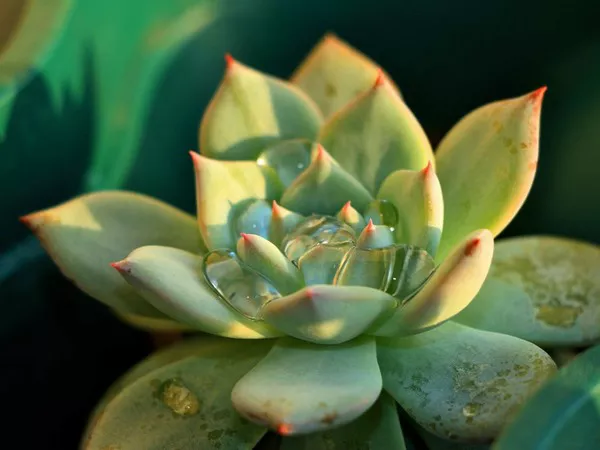Succulents, with their charming resilience and unique beauty, have become a favorite among plant enthusiasts. Whether adorning indoor spaces or gracing outdoor gardens, these water-storing wonders require specific care, especially when it comes to watering.
Understanding the Nature of Succulents
Succulents, the epitome of nature’s adaptability, are known for their ability to thrive in arid environments. The term “succulent” is derived from the Latin word “sucus,” meaning juice or sap, underscoring the plant’s exceptional water-retaining capabilities. These fleshy-leaved wonders have evolved to store water in their tissues, allowing them to withstand extended periods of drought—a feature that makes them well-suited for life in pots.
Succulents’ Unique Watering Needs
The key to successful succulent care lies in understanding their distinctive watering needs. Unlike traditional houseplants, succulents are adapted to survive in conditions where water is scarce. Overwatering is a common pitfall for succulent owners, as their roots are susceptible to rot when exposed to excess moisture. Striking the right balance is crucial for maintaining the health and vibrancy of potted succulents.
Choosing the Right Succulent Pot
The choice of the pot plays a significant role in the well-being of potted succulents. The ideal pot for succulents should have adequate drainage holes at the bottom to prevent water from accumulating, mitigating the risk of root rot. Opt for pots made of breathable materials like clay or unglazed ceramics, as these allow for better air circulation and help regulate moisture levels in the soil.
Selecting the Proper Soil Mix
Succulents thrive in well-draining soil that replicates their native habitat. A recommended soil mix for potted succulents includes a combination of potting soil, perlite, and coarse sand. This blend promotes optimal drainage, preventing waterlogged conditions that can be detrimental to succulent roots.
The Art of Watering Potted Succulents
Now that we’ve laid the foundation, let’s delve into the specifics of watering potted succulents to ensure a thriving and vibrant collection.
Frequency Matters: Succulents, by nature, prefer infrequent but deep watering. Rather than adhering to a rigid schedule, observe the moisture level in the soil. Water your succulents when the top inch of the soil feels dry. This method prevents overwatering and allows the roots to access moisture as needed.
Watering Technique: When watering potted succulents, aim to moisten the entire root ball. Ensure that water reaches the bottom of the pot, encouraging the roots to grow downward in search of moisture. Water the soil directly rather than spraying the leaves, as succulents absorb water through their roots, not their foliage.
Avoid Standing Water: After watering, it’s crucial to empty the saucer or tray beneath the pot to prevent standing water. Succulents detest soggy conditions, and stagnant water in the saucer can lead to root rot. Allow excess water to drain freely, maintaining a healthy balance between hydration and aeration.
Adjusting for Seasonal Variations: Succulents experience different growth patterns throughout the year. During the growing season, typically spring and summer, succulents may require more frequent watering. In contrast, reduce watering in the dormant season, fall and winter, to mimic their natural cycle. Pay attention to environmental factors such as temperature and sunlight, adjusting your watering routine accordingly.
Morning Watering: Aim to water your potted succulents in the morning. This allows any excess moisture on the leaves to evaporate during the day, reducing the risk of fungal diseases. Morning watering also ensures that the plant has access to water when it enters its active growth phase.
Common Mistakes to Avoid
To truly master the art of watering potted succulents, it’s essential to be aware of common mistakes that can compromise their health and longevity.
Overwatering: Succulents are not fans of consistently moist soil. Overwatering can lead to root rot and other issues. Resist the urge to water on a fixed schedule and instead rely on the “dry top inch” rule.
Inadequate Drainage: Insufficient drainage in the potting mix or a lack of drainage holes in the pot can result in waterlogged soil. Always choose pots with drainage holes and ensure your soil mix promotes proper water flow.
Ignoring Environmental Factors: Factors such as temperature, humidity, and sunlight levels directly impact the water requirements of succulents. Be mindful of these conditions and adjust your watering routine accordingly.
Using the Wrong Soil: Succulents require well-draining soil. Using a standard potting mix without amendments like perlite or sand can lead to water retention, jeopardizing the health of your succulents.
Conclusion
Successfully cultivating potted succulents is a rewarding journey that requires a nuanced understanding of their unique needs. By selecting the right pot, creating an optimal soil mix, and mastering the art of watering, you can ensure your succulents not only survive but thrive in their potted homes. Remember, the key is to strike a balance—providing enough water to sustain their beauty while avoiding the pitfalls of overwatering. With these guidelines in hand, you’re well-equipped to foster a collection of potted succulents that brings joy and natural elegance to your living spaces.


